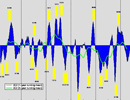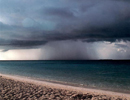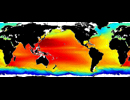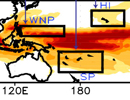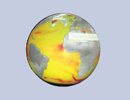IPRC Products Based on Argo Data
About Argo
The world’s oceans are continuously monitored by drifting, profiling instruments known as Argo floats. The Argo program has grown from initial deployments in 2000 to over 3,000 floats today. More information can be obtained at the Argo Information Center. Raw data from these floats, typically temperature and salinity as a function of pressure, are available at two international Global Data Assembly Centers (GDACs): one at FNMOC, the other at IFREMER.
The APDRC produces products based on individual profile data. These products include gridding in both the horizontal and vertical as well as derived variables.
Please note that this activity has for the most part been unfunded for many years. The procressing of profiles was terminated in May 2020. The velocity product remain.
About APDRC Products
The APDRC accesses Argo data daily from the US GDAC and produces a variety of products. Most are updated monthly, but a few are updated daily. The products are based on different analyses defined as follows. It should be noted that not all variables are available in all products, that there are a variety of temporal resolutions (e.g., monthly mean, seasonal mean, etc.) specific to each product, and that products can include multiple analyses.
- Horizontal binning: Also referred to as “bin averaged” or “binned”, data from profiles are collected into 1°x1° and 3°x3° squares. If no data are present for a specific grid square, this bin is set to missing.
- Horizontal gridding: Data from profiles are gridded to a regular, 1°x1° grid using an optimal interpolation method defined in [HERE]. This method interpolates over missing data, so the gridded files have values in all ocean grid points.
- Vertical interpolation: Argo floats measure temperature and salinity at discrete pressure levels, usually from 2,000 to 5 meters below the sea surface. The APDRC interpolates these data onto “standard” depth levels as well as density surfaces.
- Derived quantities: In addition to producing gridded temperature and salinity fields, the APDRC produces estimates of derived quantities such as mixed layer depth, barrier layer thickness, estimates of surface and deep (1000 meter) velocities, and more.
- Temperature-salinity profiles for the Pacific: Argo temperature and salinity are used to produce gridded 5°x5° aggregated theta vs. salinity plots for the Pacific. For comparison, climatological profiles from WOA-09 are also included on the plots. These figures show among other things water mass characteristics in the basin.
Data Product Table Click on ✔, to access the data product.
Product
| Browse1
| Browse2
| ASCII
| netCDF
| OPeNDAP
| LAS
| DChart
|
|---|---|---|---|---|---|---|---|
| 1. Variables at each float location interpolated to standard depths |
✔ | ||||||
| 2. Variables at each float location interpolated to isopycnal surfaces |
✔ | ||||||
| 3. Derived quantities at each float location (mixed layer depth, isothermal depth, etc.) |
✔ | ||||||
| 4. Derived quantities at each float location (surface and deep velocities, aka YoMaHa) |
✔ | ||||||
| 5. Horizontally-binned variables into 1°x1° and 3°x3° squares, interpolated to standard depths |
✔ | ✔ | ✔ | ✔ | ✔ | ✔ | ✔ |
| 6. Horizontally-binned Monthly mean variables into 3°x3° squares, interpolated to standard depths |
✔ | ✔ | ✔ | ✔ | ✔ | ✔ | ✔ |
| 7. Horizontally-binned variables into 1°x1° and 3°x3° squares, interpolated to isopycnals |
✔ | ✔ | ✔ | ✔ | ✔ | ✔ | ✔ |
| 8. Horizontally-binned Monthly mean variables into 3°x3° squares, interpolated to isopycnals |
✔ | ✔ | ✔ | ✔ | ✔ | ✔ | ✔ |
| 9. Horizontally-binned Mixed Layer into 1°x1° and 3°x3° squares |
✔ | ✔ | ✔ | ✔ | ✔ | ✔ | ✔ |
| 10. Horizontally-binned Monthly mean Mixed Layer into 3x3° squares |
✔ | ✔ | ✔ | ✔ | ✔ | ✔ | ✔ |
| 11. Horizontally-binned Velocities into 1°x1° and 3°x3° squares |
✔ | ✔ | ✔ | ✔ | ✔ | ✔ | ✔ |
| 12. Horizontally-binned Monthly mean Velocities into 3°x3° squares |
✔ | ✔ | ✔ | ✔ | ✔ | ✔ | ✔ |
| 13. Horizontally-interpolated variables onto 1°x1° grid on standard depths | ✔ | ✔ | ✔ | ✔ | ✔ | ||
| 14. Horizontally-interpolated derived quantities onto 1°x1° grid on standard depths | ✔ | ✔ | ✔ | ✔ | ✔ |
Documentation
Information on the optimal interpolation scheme and derived products can be found [HERE]. In brief, data were interpolated in space using a Variational Interpolation (VI) algorithm. The principle of the VI technique is to minimize the misfit between the interpolated fields defined on a regular grid and the irregularly distributed data, so the optimal solution passes as close to the data as possible. The IPRC Argo product also provided LAS/OPeNDAP/DChart access with the documentation.
Information on the velocity files from float drift can be found in YoMaHa-07
Computed quantities:
- Mixed Layer Depth (MLD): the depth on which density increases from 10m to the value equivalent to the temperature drop of 0.2°C.
- Isothermal Layer Depth (ILD): the depth on which temperature departs from its 10-m value by 0.2°C.
- Top of the Thermocline Depth (TTD): the depth, on which temperature decreases from its 10-m value by 0.2°C. TTD may differ from ILD if there is temperature inversion below 10m level.
- Temperature Inversion Depth (TID): the depth of temperature maximum, if the latter exceeds the 10-m value by at least 0.2°C.



